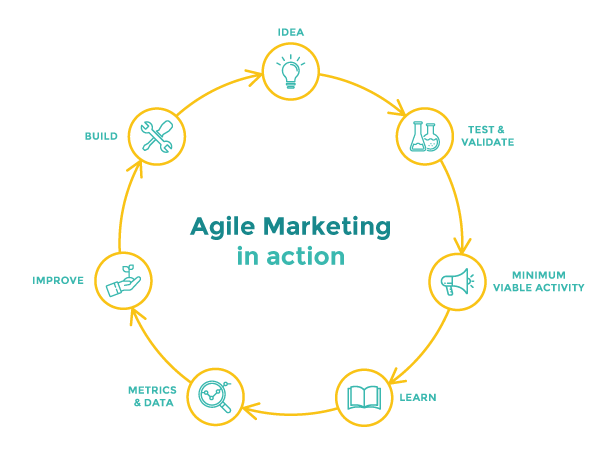It’s not just a buzzword – defining what agile marketing is, what it means for B2B and why it works.
This is the era of Agile. The ascendancy of experimentation and strategic thinking. The reign of data-driven insights. No matter your industry, everyone seems to be ‘going Agile’. Truth is, following the tech and internet revolution and the rise of Silicon Valley, every industry has had to shift to a more tech and data-driven mindset. And marketers are no different, what with our constant need to be customer centric at the forefront of market change.
But what does it actually mean to be agile in the B2B marketing industry? How do you apply an agile approach to your marketing? Most importantly, why would you leave your proven, traditional marketing techniques behind for new ways of working?
Breaking it down
To put it simply, agile marketing is exactly what it sounds like – the application of agile methodology across your marketing. However, that doesn’t give us enough to apply it effectively. In fact, you need to consider your organisational goals and how to drive the change in behaviour that’s needed for embedding a new way of working with your people, process and technology. Agile has a lot of its own lingo, so let’s take a deeper look at the key terms you’ve probably come across, and how they all work together to form an agile marketing approach.
The Basics
Agile Methodology
In 2001, visionary software developers wrote the Agile Manifesto, highlighting the vital importance of discovery and experimentation in software development. To help others build better, more customer-centric products, they detailed the need for “Individuals and interactions over processes and tools, working software over comprehensive documentation, customer collaboration over contract negotiation and responding to change over following a plan.”
Agile ways of working
Adopting an agile mindset demands redefining your marketing operational model. Where traditional marketing is restrictive, agile emphasises the freedom to be daring in your concept creation and tactics. Rather than spending months planning a solid campaign strategy, an agile marketing team takes a minimum viable approach to take an idea to market as fast as possible in order to test it with the target audience. This of course requires greater collaboration and more effective communication across teams. Don’t worry though, the hard work pays off in the end – with a noticeable boost in efficiency and productivity.
Data vs. insights
We could write an entire book on the importance of being data driven. In short, there’s a clear difference between simply gathering data about your target audience and using that data to your advantage. The most important aspect of an agile marketing approach is to turn your data into actionable insights – really dig deep into who your audience is and what solution they need, to help you build marketing strategies that make an impact.
Sprints
Having adopted agile ways of working, your marketing team will start running campaigns in short bursts – usually within two or three-week intervals called ‘Sprints’. In Sprint 0, you’ll set up data tools to continually gather insights, and create content needed for the campaign. In Sprint 1, you’ll send it all out and test it with a specific section of your audience – say, your followers on LinkedIn. Then, in Sprint 2, you’ll take what you learnt in Sprint 1, iterate, and test again. And so on and so forth.
 The Process
The Process
Test
So, how do you test, learn and iterate the agile way? By taking your concept to market as fast as possible, you’ll gain valuable time for measuring its effectiveness with your target audience. Did anyone click on your ad? How many responded to your emails? Did you receive any negative feedback about your content or design?
Retrospective
At the end of each sprint, you’ll take a hard look at those actionable insights. Taking note of what worked best with your audience and what failed to impress will help you gain a better understanding of your customers’ needs and what you need to do to reach them in the next Sprint.
Iterate
If you’ve learnt that your concept is working – great! Keep going and expand it to a wider audience. If it isn’t, change it up with a new image, subject line, USP, etc. In this iteration phase, you’ll make all improvements needed to get the results you want in the next Sprint.
This is an infinite cycle of continual testing, learning and improving that you can use throughout your campaigns and projects.
The Benefits
Agility
It’s clear that an agile marketing team is more efficient, effective and empowered. With an agile mindset, your marketing team will work more collaboratively to produce and experiment with new ideas that are more daring and innovative. What’s more, they’ll gain the skills to spring into action when needed, ready to adapt their campaigns and strategies accordingly.
Keeping Pace
Injecting agility into your marketing, is the key to keeping pace – or keeping up- with constant change in the market and the ever-changing demands of your customers. Without a doubt, this is one of the best benefits to adopting an agile marketing approach – the ability to accurately identify and take advantage of opportunities in the market for business growth and brand development.
Fit for purpose
With an agile marketing approach, you’ll see better results and improved performance. What’s more, it’ll become fit for purpose – perfectly aligned with your business goals.
The Future is Agile
There you have it, a clear breakdown of what it means for B2B marketing to be agile. As our world continues to become more digital and tech-focused, the agile approach will continue to evolve with the market, steadily gaining momentum in its influence. Adopting agile marketing and data-driven ways of working will become essential to success in B2B marketing.
Want to learn more? Check back next week for detailed look on Getting Started with Agile Marketing!

What is Agile Marketing?
This is the era of agile marketing. The ascendancy of experimentation and strategic thinking. The reign of data-driven insights. But what does that mean for B2B marketing?


 The Process
The Process